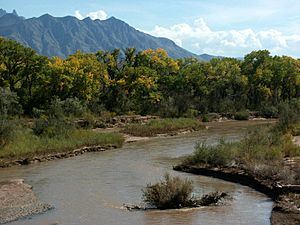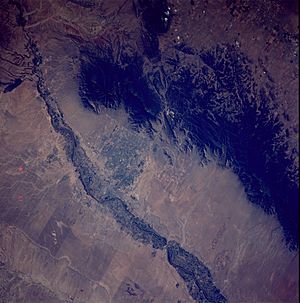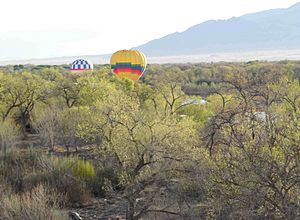Bosque facts for kids
A bosque (pronounced BOS-kay) is a special type of forest found along rivers and streams. The word "bosque" comes from the Spanish word for "woodlands." These unique forests grow on the flat areas next to rivers, called floodplains, especially in the southwestern United States.
Contents
What is a Bosque Like?
In the southwestern United States, where it's often very dry, a bosque is like a green, watery oasis. It's a strip of trees and plants that can only survive close to rivers, streams, or other water sources. The trees often form a thick roof, or canopy, overhead.
The most famous bosque is a long, green area that stretches about 300 miles (480 km) along the middle of the Rio Grande river. This river flows through New Mexico, from Santa Fe all the way south to El Paso, Texas. A very important and healthy part of this bosque is protected within the Bosque del Apache National Wildlife Refuge.
Plants and Animals of the Bosque
Many different trees grow in the bosque habitat. Some common ones include mesquite, cottonwood, desert willow, and desert olive. Because these forests often have only one main layer of tall trees, and because most of these trees lose their leaves in the fall (they are deciduous), many smaller shrubs, grasses, and other plants can grow underneath.
You might find plants like desert hackberry, blue palo verde, graythorn, Mexican elder, virgin's bower, and Indian root thriving here. The bosque is also home to many different kinds of lichen, which are tiny living things that look like moss or crusts on trees and rocks. Even though the surrounding area is a desert, the bosque has an amazing variety of living things, or biodiversity, where the forest meets the desert.
Who Lives in the Bosque?
The bosque is a very important resting spot for many birds that travel long distances, like ducks, geese, egrets, herons, and Sandhill Cranes. Other birds live in the bosque all year round, such as Red-tailed hawks, Cooper's hawks, American kestrels, hummingbirds, owls, and woodpeckers. The southwestern willow flycatcher, a small bird, also calls the bosque home.
In the water, the bosque supports special fish like the endangered Rio Grande silvery minnow. "Endangered" means there are very few of them left, and they need protection.
Helping the Bosque Grow Stronger
Over the years, human activities, fires, and plants that don't naturally belong there (called invasive species) have harmed the bosque ecosystem. But people are working hard to fix this damage.
One way to help is by removing walls and other structures, called levees, that were built along the Rio Grande to control floods. Taking these down allows the river to flow more naturally, which is good for the bosque.
Since 1996, a group called the Bosque Ecosystem Monitoring Program (BEMP) from the University of New Mexico has been working to bring the bosque back to health. They also keep a close eye on the environment and teach people how important this special forest is.




